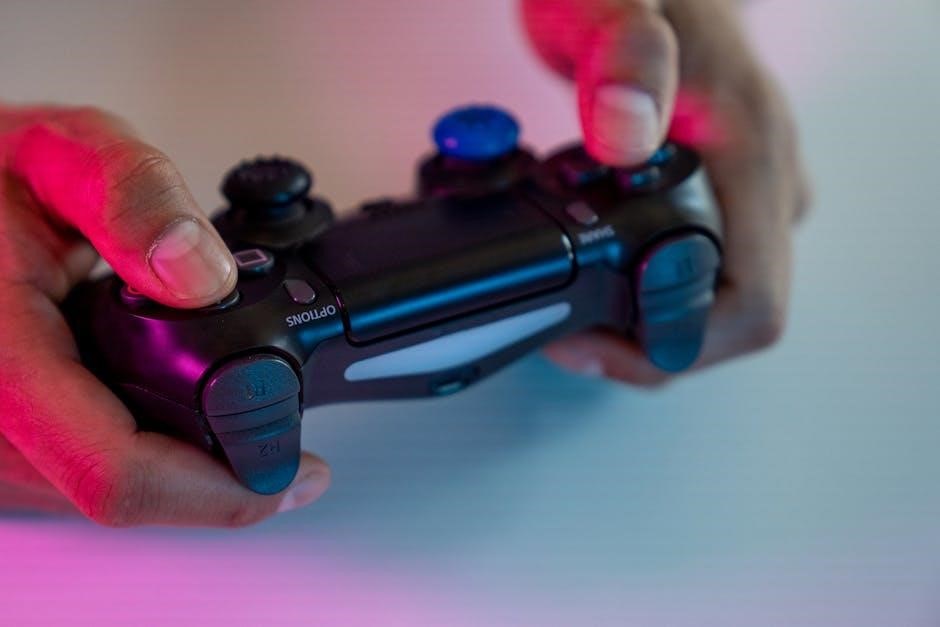Quantum Q6 Edge Controller Manual: Article Plan
This comprehensive guide details the Quantum Q6 Edge’s operation‚ encompassing power wheelchair specifics‚ controller programming‚ and vital specification details for optimal performance.
It covers joystick functionality‚ battery considerations‚ motor compatibility‚ and troubleshooting‚ alongside model variations (HD‚ Ultra‚ ZTM) and safety precautions.
Resources include Pride Mobility Australia contact information and access to online manuals‚ ensuring users have complete support for their Quantum Q6 Edge.
The Quantum Q6 Edge represents a significant advancement in power wheelchair technology‚ designed to deliver exceptional performance‚ maneuverability‚ and comfort for individuals with mobility challenges. This wheelchair isn’t simply a mobility aid; it’s an extension of personal freedom‚ engineered with precision and built for durability.
At the heart of the Q6 Edge lies its sophisticated control system‚ a crucial component that translates user input into seamless movement. Understanding this system – the controller‚ joystick‚ and associated components – is paramount to maximizing the wheelchair’s capabilities. This manual serves as a detailed guide to navigating the intricacies of the Q6 Edge’s controller‚ ensuring a safe and enjoyable user experience.
The Q6 Edge is available in several models – HD‚ Ultra‚ and ZTM – each tailored to specific needs and lifestyles. This guide will address commonalities and variations across these models‚ providing relevant information for all Q6 Edge owners. Proper maintenance and adherence to safety guidelines are essential for long-term reliability and optimal performance.
Understanding the Q6 Edge Power Wheelchair
The Quantum Q6 Edge power wheelchair is a highly configurable platform‚ designed to adapt to diverse user needs and environments. Its robust construction‚ coupled with advanced features‚ provides a stable and responsive driving experience. Key to understanding the Q6 Edge is recognizing the interplay between its mechanical components and the electronic controller system.
Factors like tire type (6″ or 8″) and condition‚ motor specifications‚ and battery capacity significantly influence the wheelchair’s performance. The controller manages power distribution to the motors‚ directly impacting speed‚ acceleration‚ and overall responsiveness. Variations in terrain and user weight also play a role‚ demanding adjustments to the controller settings for optimal operation.
This wheelchair’s single-stage gearbox contributes to precise control and efficient power transfer. Familiarizing yourself with these interconnected elements is crucial for effective operation and troubleshooting. Regular maintenance‚ as outlined in the full owner’s manual‚ ensures continued reliability and peak performance.
Controller Overview: Quantum NE Controller
The Quantum NE Controller serves as the central nervous system of the Q6 Edge power wheelchair‚ translating user input into precise movements. This controller‚ often a Curtis NE model with a 6-key switch‚ manages all power functions‚ including drive‚ steering‚ and auxiliary features. It’s designed for intuitive operation and customizable settings to accommodate individual user preferences.
The NE controller’s functionality is deeply integrated with the wheelchair’s power module (typically a 75AMP NE Plus) and joystick module. Understanding the interaction between these components is vital for effective troubleshooting and programming. The controller receives signals from the joystick‚ interprets them‚ and then directs power to the motors accordingly.
Proper calibration and programming are essential to maximize the NE controller’s potential. Accessing the controller’s settings allows for adjustments to speed‚ acceleration‚ and other parameters‚ ensuring a smooth and responsive driving experience tailored to the user’s needs.

Key Features of the Quantum NE Controller
The Quantum NE Controller boasts several key features enhancing user experience and control. Its intuitive interface‚ often utilizing a 6-key configuration‚ allows for easy navigation of settings and functions. The controller supports programmable speed control‚ enabling users to adjust maximum speed and acceleration profiles to suit their comfort and environment.
Advanced features include customizable drive profiles‚ allowing for different driving modes optimized for various terrains or maneuvers. The controller also incorporates sophisticated safety mechanisms‚ such as automatic shut-off in case of malfunction. Compatibility with various joystick modules ensures adaptability to individual user needs.
Furthermore‚ the NE Controller offers diagnostic capabilities‚ providing valuable information for troubleshooting and maintenance. Its robust design and reliable performance contribute to the overall durability and longevity of the Q6 Edge power wheelchair system.
Controller Programming Basics
Programming the Quantum NE Controller involves accessing its settings menu‚ typically through a specific key combination or sequence. Users can then adjust parameters like maximum speed‚ acceleration‚ and deceleration rates to personalize the driving experience. The controller allows for customization of joystick sensitivity‚ ensuring precise and responsive control.
Drive profile settings enable users to create different modes tailored to specific environments – for example‚ a slower‚ more controlled mode for indoor use and a faster mode for outdoor travel. Programming also includes setting up auxiliary functions‚ such as lighting control or seat adjustments.
It’s crucial to consult the full owner’s manual for detailed instructions and safety precautions during programming. Incorrect settings can affect performance and safety‚ so careful attention to detail is essential.

Controller Specifications & Technical Details
The Quantum Q6 Edge utilizes a Curtis NE controller‚ specifically the 75AMP NE Plus model‚ designated as H-1111-268 (Curtis: 17905700). This controller features a 6-key switch interface and is designed for robust performance and reliability. It operates on a voltage compatible with the Q6 Edge’s power system‚ ensuring efficient energy management.
Technical specifications include advanced microprocessor control for smooth and precise operation‚ along with integrated safety features like speed limiting and regenerative braking. The controller supports various actuator functions‚ enabling control of accessories and features. It’s designed to handle the demands of different Q6 Edge models – HD‚ Ultra‚ and ZTM – adapting to varying motor and battery configurations.
Detailed electrical schematics and wiring diagrams are available in the service manual for qualified technicians.
Joystick Module Functionality

The Quantum Q6 Edge employs a Curtis NE joystick module‚ integral to the wheelchair’s intuitive control system. This module translates user input into precise directional commands‚ governing speed and steering. Its functionality extends beyond basic movement‚ incorporating programmable features for customized driving experiences.
The joystick’s sensitivity and responsiveness are crucial‚ and regular calibration is recommended to maintain optimal performance. It supports proportional speed control‚ allowing for nuanced adjustments based on joystick deflection. The module also integrates with the controller to manage accessory functions‚ such as lighting and horn activation.
Proper joystick maintenance‚ including cleaning and inspection‚ is vital for longevity and reliable operation. Detailed calibration procedures are outlined in the service manual;
Joystick Calibration Procedures

Calibrating the Quantum Q6 Edge’s joystick module ensures accurate and responsive control. The process typically involves accessing the controller’s programming menu via a specific key sequence – often utilizing the 6-key switch. Within the menu‚ a ‘calibration’ option initiates the procedure.
The system prompts the user to move the joystick through its full range of motion‚ in all directions‚ several times. This allows the controller to establish neutral and maximum deflection points. It’s crucial to perform this on a level surface. Successful calibration is indicated by a confirmation message on the controller display.
If calibration fails‚ verify the joystick is functioning correctly and free from obstructions. Repeat the process carefully‚ ensuring full range of motion. Consult the full manual for detailed step-by-step instructions and troubleshooting tips.
Troubleshooting Joystick Issues
If the Quantum Q6 Edge joystick exhibits erratic behavior‚ begin by checking for physical obstructions or debris interfering with its movement. Ensure the joystick module is securely connected to the controller. If the issue persists‚ attempt a joystick recalibration following the procedures outlined in the manual.
Intermittent signal loss can indicate a loose connection or damaged wiring. Inspect the wiring harness for any visible damage. If the joystick feels stiff or unresponsive‚ it may require professional servicing or replacement. Erratic movements could also signal controller malfunction‚ necessitating a diagnostic check.

Consult the controller’s error codes for specific fault indications. Always prioritize safety and avoid operating the wheelchair if the joystick is malfunctioning.
Power Module Specifications (75AMP NE Plus)
The Quantum Q6 Edge utilizes a 75AMP NE Plus power module manufactured by Curtis. This module‚ identified as H-1111-268 (Curtis: 17905700)‚ is crucial for efficient power distribution and control. It’s designed to handle the demands of the Q6 Edge’s motors and accessories‚ ensuring reliable performance.
The NE Plus module features advanced current limiting and protection circuitry‚ safeguarding against overloads and short circuits. Its robust construction ensures durability and longevity. Proper operation relies on correct voltage input and compatibility with the specified battery system. Regular inspection of connections is recommended to maintain optimal functionality.
This module is integral to the wheelchair’s overall performance and responsiveness‚ working in tandem with the controller and motors.
Understanding the Controller Bracket & Adjustments
The Quantum Q6 Edge’s controller bracket is designed for optimal positioning and user comfort. Located strategically for easy access‚ the bracket allows for adjustments to accommodate various user preferences and physical needs. These adjustments are critical for ensuring precise control and minimizing strain during operation.
The bracket typically features setscrew adjustments (referenced as page 25 in related documentation) that enable fine-tuning of the controller’s angle and proximity to the user. Proper adjustment ensures the joystick is within comfortable reach and allows for intuitive operation. Carefully tightening the setscrews secures the desired position‚ preventing unwanted movement.
Regularly check the bracket’s stability and adjust as needed to maintain optimal control and user experience.
Battery Considerations & Impact on Controller Performance
The Quantum Q6 Edge’s controller performance is intrinsically linked to battery health and capacity. Maintaining optimal battery condition is crucial for consistent and reliable operation. Battery Amp Hour (Ah) rating directly influences the wheelchair’s range‚ with higher Ah ratings providing extended usage between charges.
A fully charged‚ healthy battery ensures the controller receives sufficient power for responsive operation. Conversely‚ a low charge or degraded battery can lead to sluggish responses‚ intermittent functionality‚ or even complete controller failure. Regularly monitoring battery charge and condition is therefore essential.
Factors like terrain‚ user weight‚ and motor demands also impact battery consumption and‚ consequently‚ controller performance. Understanding these variables allows for proactive battery management and prevents unexpected interruptions.
Battery Amp Hour (Ah) Rating & Range
The Battery Amp Hour (Ah) rating is a critical specification determining the Quantum Q6 Edge’s operational range. A higher Ah rating signifies a greater capacity to store electrical energy‚ directly translating to extended usage before requiring a recharge. Range varies significantly based on several factors‚ including the chosen base model‚ the user’s weight‚ and the terrain being traversed.
Battery charge level and condition also play a pivotal role. A fully charged‚ well-maintained battery will maximize range‚ while a depleted or degraded battery will substantially reduce it. Motor demands and controller type further influence energy consumption. Understanding these interdependencies is key to accurately estimating achievable range.
Consult the Q6 Edge’s specification sheet for specific range estimates associated with different Ah battery options.
Battery Charge & Condition Monitoring
Regular monitoring of battery charge and condition is essential for optimal Quantum Q6 Edge performance and longevity. The controller typically displays a battery level indicator‚ providing a visual representation of remaining charge. However‚ relying solely on this indicator isn’t sufficient. Periodic full charge/discharge cycles help calibrate the system and maintain accuracy.
Observe for any signs of declining battery health‚ such as reduced range‚ slower speeds‚ or difficulty maintaining charge. Inspect battery terminals for corrosion and ensure connections are secure. Proper battery maintenance‚ including regular cleaning and appropriate storage‚ significantly extends its lifespan.
Refer to the owner’s manual for detailed instructions on battery care and troubleshooting potential issues. Consistent monitoring safeguards against unexpected power loss and ensures reliable operation.
Motor Specifications & Controller Compatibility
The Quantum Q6 Edge utilizes high-performance motors designed for efficient power delivery and responsiveness. Motor specifications‚ including voltage and amperage ratings‚ vary depending on the specific Q6 Edge model (HD‚ Ultra‚ ZTM) and configuration. Understanding these specifications is crucial for ensuring controller compatibility and optimal performance.
The controller‚ typically a Curtis NE controller‚ is engineered to seamlessly integrate with the Q6 Edge’s motor system. However‚ modifications or aftermarket motor installations may require controller reprogramming or replacement to maintain safe and reliable operation. Always verify compatibility before making any changes to the motor or controller system.
Refer to the Q6 Edge’s specification sheet for detailed motor specifications and controller compatibility information.
Tire Type & Condition Influence on Controller Operation
The Quantum Q6 Edge’s tire type and condition significantly impact controller operation and overall performance. Both front (6″ or 8″) and rear (6″ or 8″) tire specifications influence the power required from the motors and‚ consequently‚ the demands placed on the controller. Solid tires offer durability but may transmit more vibrations‚ potentially affecting controller sensitivity.
Tire pressure and tread wear are critical factors. Underinflated tires increase rolling resistance‚ demanding more power and potentially causing the controller to work harder. Worn tires reduce traction‚ impacting responsiveness and control. Regularly inspect tires for damage‚ wear‚ and proper inflation.
Maintaining optimal tire condition ensures the controller receives accurate feedback and delivers consistent performance. Refer to the Q6 Edge’s specification sheet for recommended tire types and pressure settings.
Q6 Edge HD‚ Ultra‚ and ZTM Model Variations
The Quantum Q6 Edge is available in HD‚ Ultra‚ and ZTM models‚ each with potential variations affecting controller performance. While the core controller functionality remains consistent across these models‚ differences in base configurations‚ motor specifications‚ and overall weight distribution can influence the user experience.
The HD model typically features a robust build designed for heavier users or more demanding terrains. The Ultra model often incorporates advanced features and a refined aesthetic. The ZTM model prioritizes maneuverability and a compact design.
These variations may necessitate slight adjustments to controller programming to optimize responsiveness and efficiency. Always refer to the specific owner’s manual for the corresponding Q6 Edge model to understand any unique controller settings or considerations.

Controller Jacks and Actuators (H-1111-268)
The Quantum Q6 Edge controller utilizes specific jacks and actuators‚ identified by part number H-1111-268 (corresponding to Curtis 17905700)‚ for connecting various functions. These components facilitate communication between the controller‚ joystick module‚ and power module‚ enabling control of drive motors and accessory functions.
These jacks support connections for external devices like lighting systems‚ specialized controls‚ or data interfaces. Proper connection and functionality of these jacks are crucial for optimal system operation. Actuators manage specific wheelchair functions‚ responding to controller signals to activate features like seat elevation or tilt.
Regular inspection of these connections is recommended to ensure secure and reliable operation. Refer to the wiring diagrams in the service manual for accurate identification and troubleshooting of jack and actuator related issues.

Setscrew Adjustments & Armrest Angle
The Quantum Q6 Edge allows for personalized comfort through setscrew adjustments‚ notably impacting armrest angle. These adjustments cater to individual user preferences and postural support needs. Locating the setscrews – typically found on the armrest mounting brackets – is the first step in customization.
Loosening these setscrews enables armrest angle modification‚ allowing for forward‚ backward‚ or rotational adjustments. Carefully adjust the armrests to achieve optimal positioning‚ ensuring proper support and minimizing strain. Once the desired angle is attained‚ securely tighten the setscrews to lock the position.
Regularly check setscrew tightness to prevent unwanted movement. Refer to the owner’s manual for specific torque specifications and detailed diagrams illustrating the adjustment process.
Front & Rear Wheel Specifications (6″ & 8″)

The Quantum Q6 Edge offers versatility in wheel configurations‚ primarily featuring 6-inch (152mm) and 8-inch (203.2mm) solid wheel options for both front and rear axles. These specifications significantly influence the powerchair’s maneuverability and stability‚ particularly across varied terrains.
6-inch wheels generally provide tighter turning radiuses‚ ideal for indoor navigation and confined spaces. 8-inch wheels‚ conversely‚ enhance outdoor performance‚ offering improved obstacle-climbing ability and a smoother ride on uneven surfaces. Wheel type (solid vs. pneumatic) also impacts controller operation‚ as tire condition affects responsiveness.
Proper wheel maintenance‚ including regular inspection for wear and tear‚ is crucial. Ensure correct tire pressure (if pneumatic) and alignment to optimize performance and minimize strain on the controller and motors.
Single-Stage Gearbox & Responsiveness
The Quantum Q6 Edge utilizes an innovative single-stage gearbox designed to maximize control and responsiveness. This gearbox efficiently translates motor power to wheel rotation‚ contributing to a more direct and intuitive driving experience for the user.
Compared to multi-stage systems‚ a single-stage gearbox minimizes energy loss and reduces mechanical complexity‚ resulting in enhanced efficiency and reliability. This design directly impacts how the controller interprets user input‚ delivering precise movements and quick acceleration.
The gearbox’s robust construction ensures durability‚ even under demanding conditions. Regular inspection and maintenance‚ as outlined in the full manual‚ are vital to preserving optimal performance and responsiveness‚ ensuring seamless integration with the Q6 Edge’s controller system.
Safety Precautions When Using the Controller

Prioritize safety when operating the Quantum Q6 Edge controller. Always ensure the power wheelchair is on a level surface before initiating movement‚ and familiarize yourself with the emergency stop function – a critical safety feature.
Never operate the controller with wet hands or in excessively damp environments to prevent accidental activation or electrical hazards. Regularly inspect the joystick and wiring for any signs of damage‚ and report any issues immediately.
Be mindful of your surroundings and avoid operating the wheelchair in congested areas or near obstacles. Understand the controller’s speed settings and adjust them appropriately for the environment. Always adhere to local traffic laws and exercise caution when crossing roads.
Troubleshooting Common Controller Problems
If the controller becomes unresponsive‚ first check the battery charge level and ensure all connections are secure. A sluggish response may indicate low battery power or a need for joystick calibration – refer to the calibration procedures in this manual.
Erratic movements could stem from joystick contamination; clean the joystick module thoroughly. If the wheelchair fails to power on‚ inspect the power module and associated fuses. For issues with actuators‚ verify the controller jack connections (H-1111-268).
Should problems persist‚ consult the full specification sheets or contact Pride Mobility Products Australia for expert assistance. Remember to document the issue and any error codes displayed for efficient support.
Where to Find Additional Resources & Support
For comprehensive assistance with your Quantum Q6 Edge controller‚ Pride Mobility Products Australia offers dedicated support channels. Visit their website for downloadable manuals‚ specification sheets (including Q6 Edge 2 models – HD‚ Ultra‚ ZTM)‚ and frequently asked questions.
Direct contact information is available online for technical support and service inquiries. Access online manuals covering the Quantum NE Controller and related components‚ such as the joystick module and power module (75AMP NE Plus).
Remember to have your model number handy when contacting support. Additional resources may include authorized Quantum dealers and online forums dedicated to power wheelchair users. These platforms offer valuable insights and shared experiences.
Pride Mobility Products Australia Contact Information
To reach Pride Mobility Products Australia for support regarding your Quantum Q6 Edge controller‚ several avenues are available. While specific contact details are subject to change‚ their official website is the primary source for the most up-to-date information.
Typically‚ you can find a dedicated ‘Contact Us’ section with phone numbers for customer service and technical assistance. An online contact form allows for detailed inquiries‚ ensuring your questions are directed to the appropriate department.
Ensure you have your Quantum Q6 Edge model number and any relevant controller specifications readily available when contacting them. This will expedite the support process. Check their website for regional service centers and authorized dealers near you for localized assistance.
Accessing Online Manuals & Specification Sheets
Pride Mobility offers a comprehensive online resource library for Quantum Q6 Edge owners‚ including readily accessible manuals and detailed specification sheets. These digital resources provide in-depth information about your power wheelchair’s controller and its functionalities.
You can typically find these documents on the Pride Mobility website‚ often within a dedicated ‘Support’ or ‘Resources’ section. Search specifically for “Q6 Edge” to filter results and locate relevant materials. Available documents include the Owner’s Manual (often in PDF format)‚ detailed specification sheets outlining technical details‚ and potentially‚ troubleshooting guides.
These online resources are invaluable for understanding controller programming‚ maintenance procedures‚ and resolving common issues. Ensure you download the correct manual corresponding to your specific Q6 Edge model (HD‚ Ultra‚ or ZTM) for accurate information.
